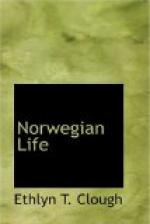The Hardanger violin, the lur and the langeleik have played a leading role in the development of Norwegian folk-songs and dances. The Hardanger instrument is more arched than the ordinary violin; there are four strings over the finger-board and four underneath, the latter of fine steel wire, acting as sympathetic strings. The men of the Hardanger fjord have long been distinguished for the workmanship and tonal qualities of their violins, and with them the peasants have improvised the rich and varied impressions of nature which we find embodied in folk-songs. The lur is a long wooden instrument, of the trumpet order, and is usually made of birch bark. It is much used in the mountains. The langeleik, or Norwegian harp, is a long, narrow, box-like stringed instrument, something of the character of the ancient zither. It has seven strings and sound holes, but its tone is weak and monotonous.
The national dances of Norway have bold rythms which at once arrest the attention. Perhaps the most characteristic is the hailing, a solo dance in two-four time. It is usually danced by young men in country barns, and its most striking feature is the kicking of the beam of the ceiling. In the story of Nils the fiddler, in his novel Arne, Bjoernson has given this account of the hailing: “The music struck up, a deep silence followed, and he began. He dashed forward along the floor, his body inclining to one side, half aslant, keeping time to the fiddle. Crouching down, he balanced himself, now on one foot, now on the other, flung his legs crosswise under him, sprang up again, and then moved on aslant as before. The fiddle was handled by skilful fingers, and more and more fire was thrown into the tune. Nils threw his head back and suddenly his boot heel touched the beam.”
The spring dance is less vigorous, but more graceful than the hailing. It is a round dance in three-quarter time, in which two persons, or groups of two, participate. It is danced with a light, springing step, and has been compared with the mazurka by Liszt. Like the hailing, however, it is markedly individual in its pleasing combinations of tones. Forestier says of the spring dance of Norway: “There is a freshness, a sparkle, and energy, a graceful life about it that is invigorating.”
If Lindeman was the first to collect folk-songs and dances in Norway, Ole Bull (1810-1880) was the first to popularize them. He was, as Grieg once declared, a pathbreaker for the young national music. At the early age of nineteen he sallied forth with his fiddle and wherever he appeared in Europe and America he played the folk-music and national dances of Norway. The favor which he found encouraged his countrymen. His brilliant career glorified musical Norway; gave it confidence to assert itself, and serve as the inspiration of a long list of creative tone artists—Kjerulf, Nordraak, Grieg, Svendsen, Winter-Hjelm, Sindling, and Behrens—to write out and arrange for voice and modern instruments the music that had so long been preserved in the memories of the people.




